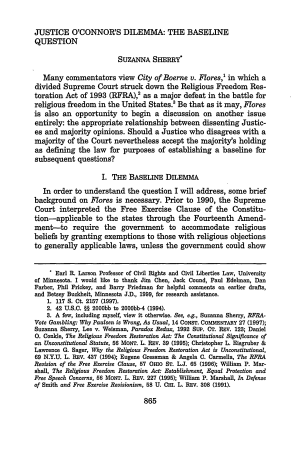Justice O'Connor's Dilemma: The Baseline Question
February 1, 1998

DISCLAIMER: This text has been transcribed automatically and may contain substantial inaccuracies due to the limitations of automatic transcription technology. This transcript is intended only to make the content of this document more easily discoverable and searchable. If you would like to quote the exact text of this document in any piece of work or research, please view the original using the link above and gather your quote directly from the source. The Sandra Day O'Connor Institute does not warrant, represent, or guarantee in any way that the text below is accurate.
Article Text
(Excerpt, Automatically generated)
JUSTICE O'CONNOR'S DILEMMA: THE BASELINE QUESTION
SUZANNA SHERRY•
Many commentators view City of Boerne v. Flores,1 in which a divided Supreme Court struck down the Religious Freedom Res toration Act of 1993 (RFRA),2 as a major defeat in the battle for religious freedom in the United St ates.3 Be that as it may, Flores is also an opportunity to begin a discussion on another issue entirely: the appropriate relationship between dissenting Justic es and majority opinions. Should a Justice who disagrees with a majority of the Court nevertheless accept the majority's holding as defining the law for purposes of establishing a baseline for subsequent questions?
THE BASELINE DILEMMA
In order to understand the question I will address, some brief background on Flores is necessary. Prior to 1990, the Supreme Court interpreted the Free Exercise Clause of the Constitu tion-applicable to the states through the Fourteenth Amend ment-to require the government to accommodate religious beliefs by granting exemptions to those with religious objections to generally applicable laws, unless the government could show
Earl R. Larson Professor of Civil Rights and Civil Liberties Law, University of Minnesota. I would like to thank Jim Chen, Jack Cound, Paul Edelman, Dan Farber, Phil Frickey, and Barry Friedman for helpful comments on earlier drafts, and Betsey Buckheit, Minnesota J.D., 1999, for research assistance.
117 S. Ct. 2157 (1997).
42 U.S.C. §§ 2000bb to 2000bb-4 (1994).
A few,
